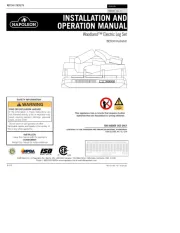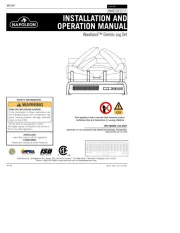Napoleon Galaxy GSS48E Bruksanvisning
Napoleon
Öppen härd
Galaxy GSS48E
Läs gratis den bruksanvisning för Napoleon Galaxy GSS48E (88 sidor) i kategorin Öppen härd. Guiden har ansetts hjälpsam av 31 personer och har ett genomsnittsbetyg på 4.7 stjärnor baserat på 16 recensioner. Har du en fråga om Napoleon Galaxy GSS48E eller vill du ställa frågor till andra användare av produkten? Ställ en fråga
Sida 1/88

FRENCH
PG. 45
W415-3006 / A / 05.27.21
DECORATIVE PRODUCT: NOT FOR USE AS A HEATING APPLIANCE.
ADD MANUAL TITLE
Wolf Steel Ltd., 24 Napoleon Rd., Barrie, ON, L4M 0G8 Canada / 103 Miller Drive, Crittenden, Kentucky, USA, 41030
Phone 1 (866) 820-8686 • www.napoleon.com • hearth@napoleon.com
CERTIFIED TO THE CANADIAN AND AMERICAN NATIONAL STANDARDS:
ANSI Z21.97 AND CSA 2.41 FOR OUTDOOR DECORATIVE GAS APPLIANCES
ADD PRODUCT CODE HERE (TRADE GOTHIC LT STD FONT)
PROPANE GAS MODELS: GSS48PE / GSS48STPE
PRODUCT NAME™
ADD ____ ILLUSTRATED
ADD PRODUCT IMAGE
SAFETY INFORMATION
- Do not store or use gasoline or other
flammable vapors and liquids in the vicinity of this
or any other appliance.
- An LP-cylinder not connected for use shall not be
stored in the vicinity of this or any other appliance.
WHAT TO DO IF YOU SMELL GAS:
• Do not try to light any appliance.
• Shut off gas to the appliance.
• Extinguish any open flame.
• If odour continues, leave the area immediately.
• Do not touch any electrical switch; do not use
any phone in your building.
• Immediately call your gas supplier from a neigh-
bour’s phone. Follow the gas supplier’s instruc-
tions.
• If you cannot reach your gas supplier, call the fire
department.
Failure to follow these instructions could result in
fire or explosion, which could cause property dam-
age, personal injury, or death.
- Installation and service must be performed
by a qualified installer, service agency, or the
gas supplier.
This appliance is only for use with the type of gas
indicated on the rating plate. This appliance is
not convertible for use with other gases, unless a
certified kit is used.
If the information in these instructions are not
followed exactly, a fire or explosion may result
causing property damage, personal injury or
loss of life. Read the installation, operating and
maintenance instructions thoroughly before
installing or servicing this equipment.
WARNING
!
ENGLISH
$10.00
INSTALLATION AND
OPERATION MANUAL
Galaxy™ Series
(GSS48E Illustrated)
NATURAL GAS MODELS: GSS48NE / GSS48STNE
FOR OUTDOOR USE ONLY
IF INSTALLATION + OPERATION, ADD SERIAL
NUMBER LABEL HERE
IF SEPARATE MANUALS, ADD “PLACE
BARCODE LABEL ON THE OWNER’S MANUAL”
SERIENNUMMER VOM KARTON AUFBRINGEN
Seriennr.
MODELL-NR.
BRENG HET SERIENUMMER VAN DE DOOS AAN
Serienr.
MODELNR.
NANESTE SÉRIOVÉ ČÍSLO Z KARTONU
Sériové číslo:
ČÍSLO MODELU:
INSTALLER:
Leave this manual with the appliance
CONSUMER:
Retain this manual for future reference
Produktspecifikationer
| Varumärke: | Napoleon |
| Kategori: | Öppen härd |
| Modell: | Galaxy GSS48E |
Behöver du hjälp?
Om du behöver hjälp med Napoleon Galaxy GSS48E ställ en fråga nedan och andra användare kommer att svara dig
Öppen härd Napoleon Manualer

13 Februari 2025

8 Januari 2025

8 Januari 2025

7 Januari 2025

1 Oktober 2024

1 Oktober 2024

1 Oktober 2024

1 Oktober 2024

1 Oktober 2024

26 September 2024
Öppen härd Manualer
- Dimplex
- Jotul
- Well Straler
- La Nordica
- Livn
- Furrion
- Quigg
- Euromac
- Lund
- Manor House
- Ambiano
- Jøtul
- Norsk Kleber
- Firefriend
- Qlima
Nyaste Öppen härd Manualer

5 April 2025

2 April 2025

10 Mars 2025

10 Mars 2025

10 Mars 2025

10 Mars 2025

10 Mars 2025

20 Februari 2025

13 Februari 2025

11 Februari 2025